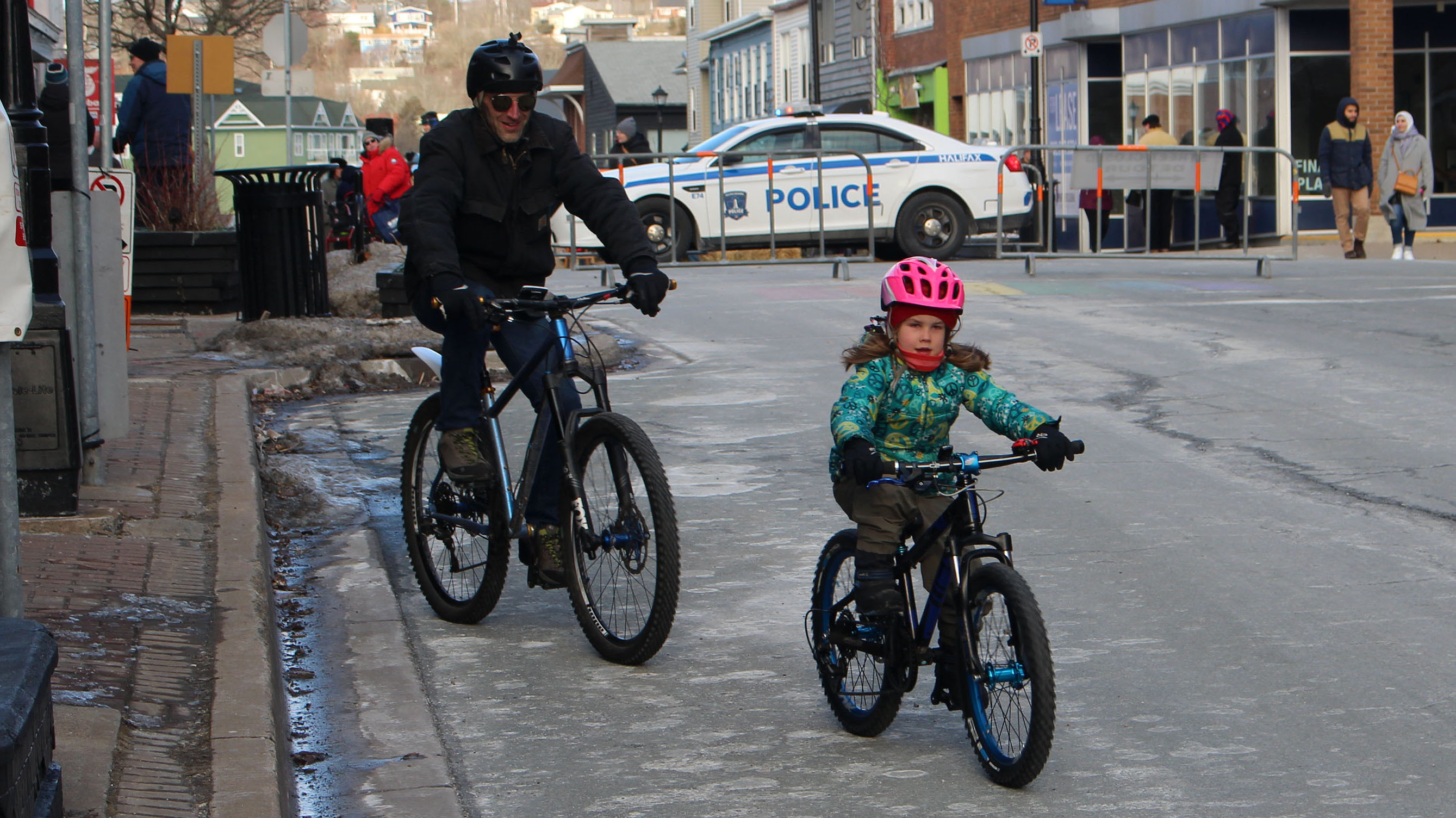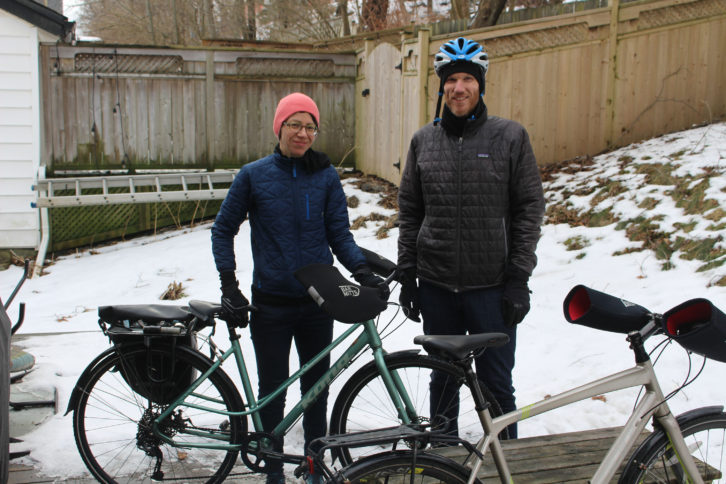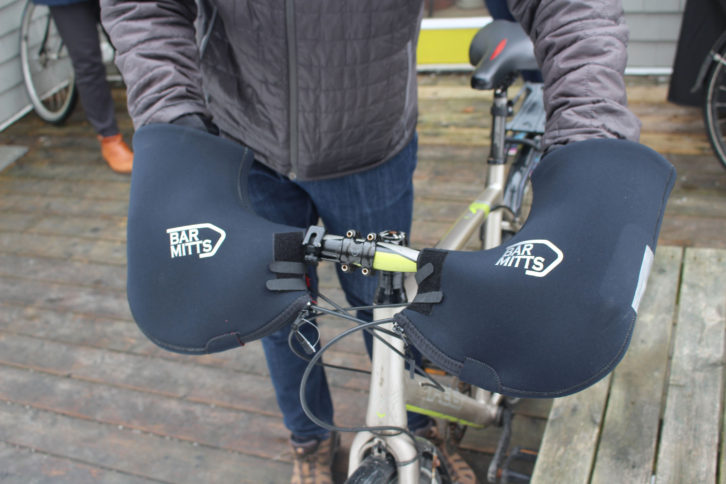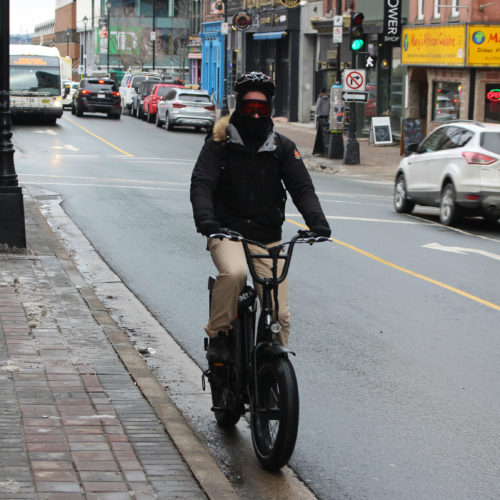Winter Bike Week shows Halifax how cyclists beat the cold
The Signal meets up with some winter cyclists to see how

caption
Marc Rickard (left) bikes with his daughter Ivy (right) down Portland Street in Dartmouth. They were out for the first day of Winter Bike Week in Halifax, which started Feb. 8.Stop me if you’ve heard this one.
A cyclist in Halifax posts online that they would like to see Halifax pay for infrastructure that would make the city friendlier to bicycles. A motorist responds with an attack on how Halifax isn’t suitable for bicycles and spending money on that kind of infrastructure would be a waste of tax dollars on a small fraction of the population.
A hundred comments later, many of them can be summed up with a simple statement: Halifax can’t be a bicycle city because you can’t cycle in the winter.
Not all Haligonians agree. Related stories
This week, the Halifax Bicycle Coalition hosted events around the city for Winter Bike Week. The week is now over, but the winter isn’t. So how do you pedal around this town when the slush, salt and snow are everywhere?
The Signal took to the bicycle lanes this week to meet up with some of the town’s winter cyclists and ask them how they do it.

caption
Jillian Banfield (left) stands with husband Dan Peterson and their bicycles in their backyard in Halifax. Banfield is Halifax’s Bicycle Mayor.Jillian Banfield is Halifax’s bicycle mayor. As part of the international Bicycle Mayor and Leaders Network, she cycles around Halifax to promote all things bicycle.
She and husband Dan Peterson live in Halifax’s north end and cycle all over the peninsula. Banfield makes a daily commute to the south end and back for work.

caption
Bicycle Mayor Jillian Banfield rides with Dan Peterson and John Kyle through Halifax’s north end during Winter Bike Week.Banfield had arthritis as an infant, which has led to mobility issues in adulthood. Biking is the easiest way for her to get around physically.
“I can’t walk on icy sidewalks, I can’t even walk down to the bus stop here. So it’s door to door service for me. That’s the best thing for my limited mobility,” she said.
For Banfield, bicycling is the fastest, most inexpensive way around town.

caption
Dan Peterson uses these mitts attached to his handlebars to keep his hands warm while cycling through the snow.Peterson doesn’t bike in the winter as regularly as his wife, but he’s getting used to riding in the cold.
“People might see the snow around and the ice patches and think it’s super cold,” he said. “As long as you dress appropriately and bundle up a bit, you’ll be fine.”
He uses mitts attached to the bike handles to protect his hands from the wind. Hats under helmets, scarves and wind-resistant jackets are also recommended.

caption
Metal studs in the bike tires give riders more traction on ice. Jillian Banfield calls them a “game changer” in the winter.Banfield recommends studded tires to anyone who wants to get into winter cycling. The tires run about $70 each, but make it much easier to glide over the slick winter roads. She started using them two years ago and hasn’t looked back. She said they aren’t necessary, but are much safer.
“Last winter we had so much ice and I just rode over everything. That really was a game changer for me.”

caption
John Kyle rides on the road to avoid the ice and snow in the bike lane on Windsor Street.Out on the road, Banfield said a common problem in the winter is that bicycle lanes aren’t cleared regularly. This can push bikes onto the roads with cars. She would like to see Halifax make clearing bike lanes a priority. She’d also like more bike lanes with barriers to protect cyclists from traffic.
Despite the sometimes subpar conditions, John Kyle says he still prefers his bike to a car.
“I find biking fun and driving stressful. It’s as simple as that,” he said.

caption
Dan Peterson cleans the salt and water off his bike after a winter ride.Winter cycling is demanding on bicycles. The salt in the air and the salt we add to the roads are tough on a bicycle’s moving parts, such as the chains and brakes.
Steady cleaning and lubricating keep bikes safe for winter biking.

caption
A rusted chain shows the importance of keeping your bike clean and dry in the winter.Peterson’s chain is a warning of what happens when cyclists forgo regular upkeep and maintenance in the winter.
The key, Banfield said, is to keep your bike clean and dry during the winter. The maintenance doesn’t have to be major, just regular.

caption
Mike James cruises down Barrington Street in downtown Halifax. The fat tires on his bike are a good option for better traction in the winter.Mike James was bundled up in goggles and a scarf as he biked in downtown Halifax. His fat tires have better tread in the winter, so he doesn’t have to worry about road conditions as much as the average cyclist. He cycled downtown from Devonshire Avenue in the north end in five minutes.

caption
Ivy Rickard stands in her father’s bike shop in Dartmouth. She said she likes biking in the winter better than walking.On the first day of Winter Bike Week, Ivy Rickard was at the Bike Pedaler, her father Marc Rickard’s bike shop on Portland Street in Dartmouth. Marc said he “sold” the business to Ivy for $1. He runs the business, but Ivy makes sure to check in regularly.
“My favourite part of biking in the winter is that you get to be outside,” said Ivy. “And it’s hard to walk in snow pants. It’s actually easier to ride a bike.”

caption
Alexander Soucy doesn’t wait for the snowplow before leaving an event at the Sea Horse Tavern during Winter Bike Week.Alexander Soucy is a cultural anthropologist at Saint Mary’s University. He rode his bike through the snow to give a short talk at the Sea Horse Tavern on Tuesday as part of Winter Bike Week.
He thinks bikes have many advantages to cars. He said bicycles are cheaper, better for health and the environment, and a quicker way to get around the city. He’s hoping to begin research on how bicycle transportation influences human society.
“Do people see bicycles as toys or transportation?” Soucy asked the crowd on Tuesday. “Are they solutions or are they nuisances?”
Personally, he sees them as a transportation solution in cities.

caption
David Hamp-Gonsalves stands with his bicycle outside a Winter Bike Week event on Tuesday. He said he prefers riding in a snowfall.David Hamp-Gonsalves likes the exercise. The software engineer rides every day in the winter. He said he actually looks forward to a good bike ride through the snow.
“I really like riding in weather like this. It’s the only time you have to think about riding. You can slip, it’s interesting and there’s nobody on the roads.”

caption
Coun. Shawn Cleary rode through his district in the snow to pick up groceries on Quinpool Road Thursday.Halifax municipal Coun. Shawn Cleary rides his bike year-round. This week, he stopped by his local grocery store on Quinpool Road to stock up for dinner, and possibly to grab some storm chips.
He said some of the most consistently emotionally charged emails he receives concern bicycle law and infrastructure.
As part of a Winter Bike Week event on Tuesday, Cleary spoke to a crowd of cyclists at the Sea Horse Tavern about how to best advocate for bicycle legislation.
The night before, the Halifax Cycling Coalition handed out awards and Coun. Sam Austin won “Favourite bicycle-friendly councillor” this year.
Cleary was good-humoured about it.
“It’s a popularity contest,” he joked.

caption
Some bugs stay out in the winter. Ivy Rickard rings her bell before getting ready to ride home with her dad.Winter Bike Week ends Saturday night with a film screening at the Museum of Natural History at 7 p.m.
About the author
Ethan Lycan-Lang
Ethan Lang is a student journalist at the University of King’s College. Originally from the Annapolis Valley, he spent a few years on the Rock...
